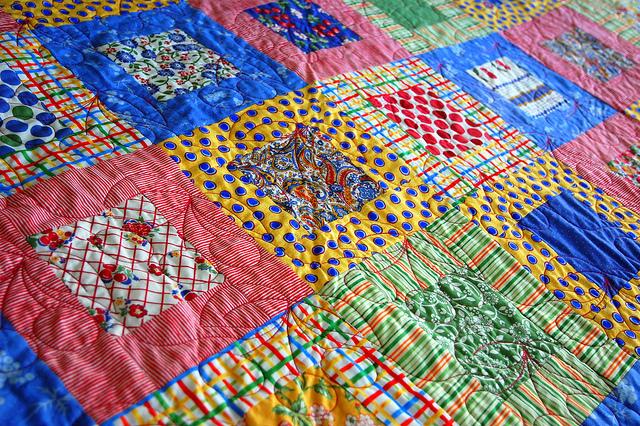Community Voices features opinion pieces from a wide variety of authors and perspectives. (Submission Guidelines)
Talking about Race — Piecing together the quilt

Talking about race and learning about race is like piecing together a quilt . . .

Kate Towle offers this blog, talking about race
Kate Towle
Background on Kate Towle and Her Thoughts About Race
Though my white father died when I was 10, I imprinted his passion for civil rights as he worked alongside an African-American friend to sustain a community center. He also had Social Security documents translated into Spanish and visited young men in prison. When I had children of my own, I learned how intricately their educational experience was tied to that of their peers of color. We became the rare white family that talks about race. We’re long overdue for the conversation; only then will we understand events like #Ferguson and #Charleston.
We Are Creatures of Patterns
If, for instance, you are a descendant of slaves, the stories that passed on to you are less likely to be about the independence gained through the Revolutionary War and more about the dignities stripped from you and your children, or your ancestors’ lives in slavery. Not only would your family be denied opportunities to reach prosperity, your cultural legacy would boast less to pass on, including books and photographs. Though now granted civil rights in 1964 (only 51 years ago) you are expected to make do with inferior housing, schools, and even health care.
The Counter-narrative to ‘Shining city …’
I have learned a counter-narrative to that of the U.S. as a “shining city on the hill” by staying present to the pain of my friends of color. In fact, our country was founded by white colonists who funded the war for independence with wealth created by slave labor. The surplus wealth of our country for half of its lifetime (from the first Jamestown settlement) was generated by a massive slave trade that sanctioned violently seizing land and people. Our society has had legalized slavery far longer than it has been free. A worldview of white dominance taints everything from our cultural reaction to drugs (crack vs. anti-depressants) to the correlation of education and your ZIP code. Our societal practices still bow to the wealth that white people have been able to invest, save and generate over time.
Holding the perspective of our friends of color requires that we intentionally increase our exposure to the reality and obstacles they experience. Learning the truth about race within the U.S. is a process of learning and exposure, akin to learning about another country. Each of us brings our square of exposure to the quilt.
Embrace one key practice
If we hope to increase prosperity and maximize the quality of life for all, we must encourage each U.S. citizen to embrace one key practice: talking constructively — and with an open mind — about race.
The stakes have never been higher. Our divisions as a nation are making us increasingly vulnerable to terrorism and the demands of regimes that oppose our best interests. The world itself is experiencing the strain of overpopulation and climate change, and will require the intelligence of every young mind.
Laying the groundwork in early childhood
The following thoughts were added to Kate’s blog by Julie Penshorn
I wanted to make sure all were aware that Teaching Tolerance has many valuable tools for your classroom community as well as your faculty.
Here is a suggestions from a recent article from The Greater Good Magazine. Discuss with staff at a staff meeting, “The hard part of talking a bout race/racism is …” and “The beneficial part of talking about race/racism is…”
A valuable resource geared for slightly older children than our target group at Smart Tools for Life is available here: “Teaching Tolerance Guide: Let’s Talk.” However, many of these ideas can be adapted. You’ll also see how valuable our children’s book The Barnyard Buddies STOP for Peace is when you look at the Teaching Tolerance group activities. Young children learn the basic tools in our work. Then, those skills can be expanded upon in older classrooms and children will have the preparedness to move forward easily. We will follow up with more ideas for young children.
Please Add Your Voice! Share Your Ideas!
If you’re interested in joining the discussion, add your voice to the Comment section below. Have you instituted a practice in your classroom that would be of benefit to others? Do you have a favorite book you’d like to tell us about? How about a teacher training circle exercise you use in your setting? We welcome your insights and encourage a dialogue.